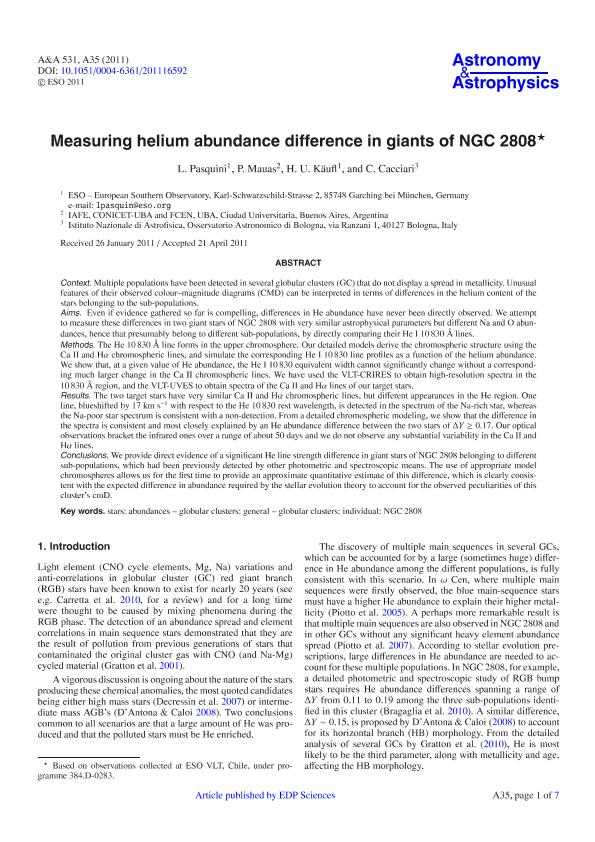Artículo
Measuring helium abundance difference in giants of NGC 2808
Fecha de publicación:
07/2011
Editorial:
EDP Sciences
Revista:
Astronomy and Astrophysics
ISSN:
0004-6361
Idioma:
Inglés
Tipo de recurso:
Artículo publicado
Clasificación temática:
Resumen
Context. Multiple populations have been detected in several globular clusters (GC) that do not display a spread in metallicity. Unusual features of their observed colour–magnitude diagrams (CMD) can be interpreted in terms of differences in the helium content of the stars belonging to the sub-populations. Aims. Even if evidence gathered so far is compelling, differences in He abundance have never been directly observed. We attempt to measure these differences in two giant stars of NGC 2808 with very similar astrophysical parameters but different Na and O abundances, hence that presumably belong to different sub-populations, by directly comparing their He I 10 830 Å lines. Methods. The He 10 830 Å line forms in the upper chromosphere. Our detailed models derive the chromospheric structure using the Ca II and Hα chromospheric lines, and simulate the corresponding He I 10 830 line profiles as a function of the helium abundance. We show that, at a given value of He abundance, the He I 10 830 equivalent width cannot significantly change without a corresponding much larger change in the Ca II chromospheric lines. We have used the VLT-CRIRES to obtain high-resolution spectra in the 10 830 Å region, and the VLT-UVES to obtain spectra of the Ca II and Hα lines of our target stars. Results. The two target stars have very similar Ca II and Hα chromospheric lines, but different appearances in the He region. One line, blueshifted by 17 km s-1 with respect to the He 10 830 rest wavelength, is detected in the spectrum of the Na-rich star, whereas the Na-poor star spectrum is consistent with a non-detection. From a detailed chromospheric modeling, we show that the difference in the spectra is consistent and most closely explained by an He abundance difference between the two stars of ΔY ≥ 0.17. Our optical observations bracket the infrared ones over a range of about 50 days and we do not observe any substantial variability in the Ca II and Hα lines. Conclusions. We provide direct evidence of a significant He line strength difference in giant stars of NGC 2808 belonging to different sub-populations, which had been previously detected by other photometric and spectroscopic means. The use of appropriate model chromospheres allows us for the first time to provide an approximate quantitative estimate of this difference, which is clearly consistent with the expected difference in abundance required by the stellar evolution theory to account for the observed peculiarities of this cluster’s cmD.
Archivos asociados
Licencia
Identificadores
Colecciones
Articulos(IAFE)
Articulos de INST.DE ASTRONOMIA Y FISICA DEL ESPACIO(I)
Articulos de INST.DE ASTRONOMIA Y FISICA DEL ESPACIO(I)
Citación
Pasquini, L.; Mauas, Pablo Jacobo David; Käufl, H. U.; Cacciari, Carla; Measuring helium abundance difference in giants of NGC 2808; EDP Sciences; Astronomy and Astrophysics; 531; 7-2011; A35,1-7
Compartir
Altmétricas




